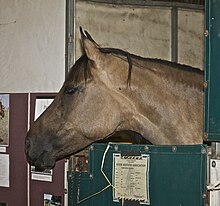Kiger mustang
 Mesteño, a Kiger mustang stallion | |
| Country of origin | United States |
|---|---|
| Traits | |
| Distinguishing features | Some horses are gaited, every equine color, although dun is most common. Athletic, strong. |
| Breed standards | |
The Kiger mustang is a strain of
Kiger mustangs are most often
Characteristics

Kiger mustangs are most commonly
Kiger mustangs generally stand 13.2 to 15.2 hands (54 to 62 inches, 137 to 157 cm) high. They are compact, well-muscled horses with deep chests and short backs. In general, they are agile and intelligent, with the stamina and sure-footedness seen in many feral horse breeds. They are generally bold but gentle and calm. They are used for pleasure riding as well as endurance riding, assorted performance competition under saddle, driving, and many other situations where an athletic horse is desired.[3][4]
History
Horses have been present in the
Discovery of the Kiger mustang was the result of a BLM mustang roundup in the Beatys Butte area[5] in Harney County in 1977. During the roundup, it was noticed that among the horses collected from the area, there was a group with similar color and markings. DNA testing by the University of Kentucky showed close relation to the Iberian horses brought to the Americas by the Spanish in the 17th century. These distinct horses were separated from the other horses and the BLM placed two groups in separate areas of Steens Mountain to preserve the breed. Seven horses were placed in the Riddle Mountain Herd Management Area (HMA) and twenty in the Kiger HMA.[1]
In 2001, the Kiger mustang was proposed as the
BLM management and private ownership
The
References
- ^ a b "History of the Kiger Mustang". Kiger Mesteño Association. Archived from the original on March 8, 2015. Retrieved February 9, 2012.
- ^ "KMA Official Rule and Regulation Book" (PDF). Kiger Mesteño Association. July 2010. p. 13. Archived from the original (PDF) on 2014-01-03. Retrieved January 3, 2014.
- ^ a b c d e f "Kiger Mustang". The International Museum of the Horse. Archived from the original on July 24, 2014. Retrieved February 9, 2012.
- ^ ISBN 1580176135.
- ^ "Beatys Butte". Geographic Names Information System. United States Geological Survey, United States Department of the Interior. November 28, 1980. Retrieved February 9, 2012.
- ^ Steves, David (January 23, 2001). "Senator trots out horse nominee". The Register-Guard. Eugene, Oregon: Guard Publishing. Archived from the original on November 23, 2015. Retrieved October 16, 2013.
- ^ "Oregon State Symbols". The Oregon Encyclopedia. Portland State University. Archived from the original on May 21, 2014. Retrieved October 16, 2013.
- ^ "Spirit". Return to Freedom American Wild Horse Sanctuary. Archived from the original on December 14, 2012. Retrieved February 9, 2012.
- ^ "Kiger and Riddle Mountain Herd Management Areas" (PDF). Bureau of Land Management. Archived (PDF) from the original on October 18, 2013. Retrieved October 17, 2013.
- ^ "Kiger Mustangs Up For Adoption in Burns, Oregon" (PDF). Bureau of Land Management. October 23, 2007. Archived (PDF) from the original on October 18, 2013. Retrieved October 17, 2013.
- ^ "Wild Horse Adoption: Kiger Kraze 2011" (PDF). Bureau of Land Management. Archived (PDF) from the original on October 18, 2013. Retrieved October 17, 2013.
- ^ "Burns District Planning Update: Fiscal Year 2008" (PDF). Bureau of Land Management. p. 45. Archived (PDF) from the original on October 18, 2013. Retrieved October 17, 2013.
- ^ "Home". Kiger Mesteño Association. Archived from the original on September 17, 2013. Retrieved October 16, 2013.
- ^ "Home". Steens Mountain Kiger Registry. Archived from the original on October 17, 2013. Retrieved October 16, 2013.
- ^ "Home". Kiger Horse Association and Registry. Archived from the original on September 14, 2013. Retrieved October 16, 2013.
- ^ "Wild Horses in Oregon". The Oregon Encyclopedia. Portland State University. Archived from the original on May 21, 2014. Retrieved October 16, 2013.
- ^ "Oregon BLM Wild Horse and Burro Population Data" (PDF). Bureau of Land Management. February 27, 2013. Archived (PDF) from the original on October 18, 2013. Retrieved October 17, 2013.
External links
- Map of the Kiger Mustang Area of Critical Environmental Concern - Proposed RMP (PDF) from the BLM
- Images of Kiger mustangs from The Oregonian
- Breed registry
